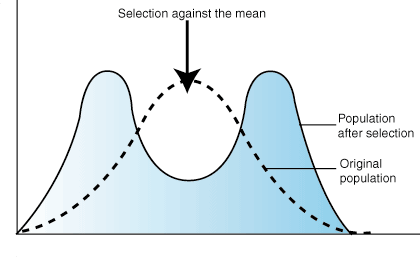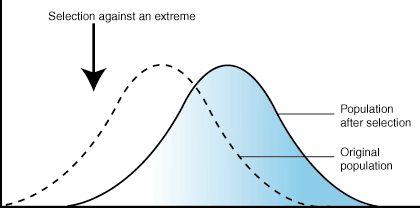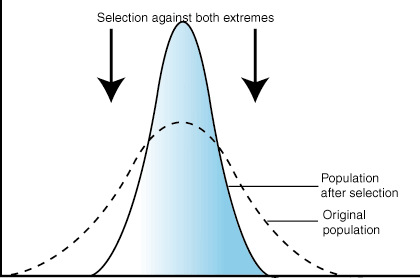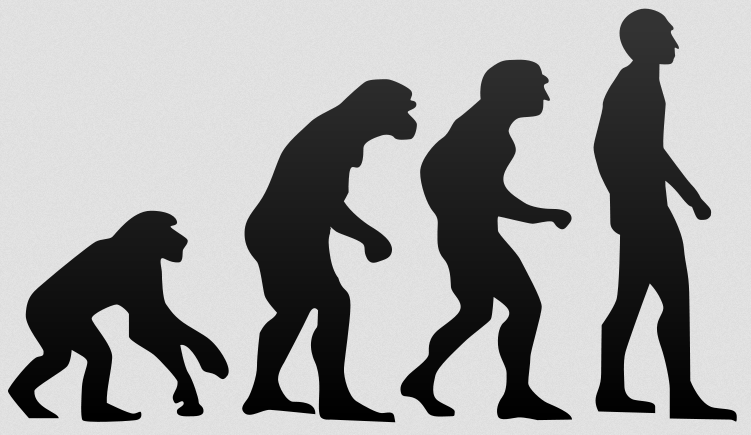| Evolution Refresher Course |
| Evolution Concepts Files |
| Evolution Master Files |
| Evolution Revision Note |
| Evolution Note 1 |
| Evolution Reference Book |
Evolution
Table of Content
- Definition of Evolution
- Example of Evolution
- Mechanism of Evolution
- Natural Selection
- Types of Natural Selection
- Darwin’s Theory of Evolution
- Modern understanding
- Evolutionary Change
- Human Evolution
- Frequently Asked Questions
Definition of Evolution
“Evolution is change in the heritable characteristics of biological populations over successive generations. Evolutionary processes give rise to biodiversity at every level of biological organization, including the levels of species, individual organisms, and molecules.”
Example of Evolution
Peppered moth initially had light colored which was darkened after Industrial Revolution, due to population. This mutation occurred because light colored moths were easily seen by birds, therefore, darkening of them helped in surviving from birds.
Example of Evolution and Mechanism of Evolution
“Microevolution refers to the change in allele frequencies within a single population.” Allele frequencies changes due to four major forces of evolution, i.e. Natural Selection, Genetic Drift, Mutation and Gene Flow.
What drives evolution: Mutation or Genetic Recombination?
Mutation and genetic recombination are the two possible sources that results in genetic variability. “Mutations are random nucleotide alterations such as copying errors or changes induced due to external mutagens.” On contrary, “genetic recombination is performed by the cell during the preparation of gametes (pollen, egg or sperm) that are used during sexual reproduction.”
Both of these processes contribute to the evolution of an organism but genetic recombination is considered as the primary source of enabling genetic distinctions between individuals in a population and is therefore, considered as principal driving force that results in evolution.
Natural Selection
Natural selection is the basic mechanism of evolution along with migration, mutation and genetic drift.
Definition of Natural Selection
“The process whereby organisms better adapted to their environment tend to survive and produce more offspring is referred as natural selection.” The adaptation takes place by means of selectively reproducing changes in its genetic constitution.
Example of Natural Selection
Tree frogs are sometimes eaten by birds and snakes. Amongst these grey tree frogs blend well in the areas with dark wood tree bark while green tree frogs blend well with green vegetation found in swamp and marshes.
A green tree frog on bark of tree is easy to be found by predator as compared to a green tree frog on green leaves. So, natural selection has favored those tree frogs that live in habitats in which they are more camouflaged.
In natural selection, the variations in genotype which increases the chances of survival of an organism and procreation are retained and multiplied in generations at the expense of less advantageous ones. Thus, natural selection arises from the differences in survival in rate of development, in fertility, in mating success and several other aspects. These all differences result in natural selection to the extent that they impact the number of progeny.
Gene frequencies remain constant in different generations in the absence of any disturbing factors. The factors that can create disturbances are migration (gene flow), mutation and random genetic drift.
Types of Natural Selection
- Stabilizing Selection – “When selective pressures select against the two extremes of a trait, the population experiences stabilizing selection.” Let us consider an example of plant height. A plant that is too short is not able to compete with other plants while the extremely tall plant may be more susceptible to wind damage. When these two selection pressures are combined, it helps in maintaining the medium plant height. As a result of stabilizing selection, the number of plants with medium height will increase, while tall and short ones will decrease.
Following figure shows the selection against two extreme traits

Figure 2
- Directional Selection – “In direction selection, one extreme of the trait distribution experience selection against it.” As a result of this selection, the population trait distribution shifts towards the other extreme. Considering the example of giraffe, there was the selection pressure against short necks as they were not able to reach the leaves of the trees. As a result, the distribution of length of neck was shifted in the favor of giraffes, i.e. the individuals with longer neck.
Following figure shows the effect of directional selection on trait distribution

Figure 3
- Disruptive Selection – “In disruptive selection, selection pressures act against individuals in the middle of the trait distribution.” The outcome may be two peaked or bimodal. Consider an example of a plant with variable height pollinated by three different pollinators, i.e. one attracted to short plants, second attracted to medium plants and third visit only the tallest plant. If the pollinators which preferred plant height are disappeared from the area, medium height plants will be selected against the population of short and tall plants. Such a population, with several distinct forms is referred as polymorphic.
Following figure shows the effect of disruptive selection on trait distribution.

Figure 4
Darwin’s Theory of Evolution
This theory of evolution is one of the most substantiated theories in the science history because it is supported by wide variety of scientific disciplines i.e. geology, paleontology, developmental biology and genetics. The theory of evolution was first formulated by Charles Darwin in the year 1859. According to him, organisms change overtime behaviorally or physically. These changes allow the organisms to adapt to the environment such that they are able to survive and have more offspring.
The two main points of this theory are as follows –
- “All life on earth is connected and related to each other.”
- “The diversity of life is the product of modifications of population by natural selection.”
Modern understanding
Darwin was not aware of genetics, rather he observed only the pattern of evolution. After the discovery of genes, its importance, behavioral or physical traits and passing of genes were studied later. This resulted in corporation of genetics and Darwin’s theory which was termed as “Modern Evolutionary Synthesis.” According to this theory, the behavioral and physical change that occurs as a result of natural selection happens at DNA level and such changes are called mutations. Mutation can also cause random error in replication or repair of DNA due to radiation or chemical damage. In several cases, mutation can be neutral or harmful, while in some cases it also proves beneficial to the organisms.
Evolutionary Change
It is the constant process of gradual changes in physical or behavioral traits of organisms. It is the slow and continuous process. Evolutionary changes takes in following manner –
Catastrophism and Gradualism – Evolution includes change over the period of time. In catastrophism, the pattern of evolution is based on assumption that several catastrophic events separate the distinctive boundaries on fossil record. These catastrophes are floods, volcanic eruptions or droughts. This theory was proposed by George Cuvier. According to him, these catastrophic events have the local impact and thus, affect the organisms living in that specific area. Extinction of dinosaurs is considered as the result of catastrophic events.
On contrary to catastrophism, as per gradualism, changes take place continually over a long period of time. Thus, according to it, change did not occur as a result of huge event, rather it a gradual process whereby change takes place from generation to generation.
Human Evolution
“It is the evolutionary process that led to the emergence of anatomically modern humans.” The study of human evolution involves several scientific disciplines, such as primatology, anthropology, paleontology, archaeology, ethology, neurobiology, evolutionary psychology, linguistics, genetics and embryology.
Human evolution is a lengthy process and includes the change of present humans from ape like ancestors. As per the available scientific evidences, our behavioral and physical traits are originated from ape like ancestors and have gradually evolved over a period of approximately 6 million years.
Bipedalism (ability to walk on two legs) is one of the earliest defining traits which evolved 4 million years ago. Other characteristics like large and complex brain, capacity for language, ability to use and make tools, etc. were recently developed.
The process of Evolution
The process of evolution includes series of natural changes that cause species to arise, adapt to environment and become extinct. All organisms and species are the outcome of process of evolution. Evolution occurs with the change in genetic material that is inherited from parents. Here, genes represent “the segment of DNA that provide the chemical code for producing proteins.” Evolution does not change any single individual rather it changes the inherited means of growth and development. Parents pass genetic changes that are adapted to offspring and finally these changes become permanent or common throughout the population.
Frequently Asked Questions (FAQs)
Q1: Define mutation, migration and random genetic drift.
Answer: The term mutation is defined as “the spontaneous change in the gene frequency that takes place in population and occurs at low rate.”
“Migration is the local change in gene frequency when an individual moves from one population to another and then interbreeds.”
“Random genetic drift is the change that takes place from one generation to another by the process of pure chance.
Q2: How does the species evolve?
Answer: The changes in DNA takes place as it passes from one generation to another. DNA mutations sometimes affect the appearance of animals and sometimes the way in which boy works. Majority of times, the new version of gene survives better than an animal of old version and as per “survival of fittest” theory offspring adapt those changes and thus, evolution of species takes place.
Q3: What is adaptive radiation?
Answer: “In evolutionary biology, adaptive radiation is the process in which organisms diversify rapidly from an ancestral species into the multitude of new forms, particularly when a change in the environment makes new resources available, create new challenges or open new environmental niches.”
